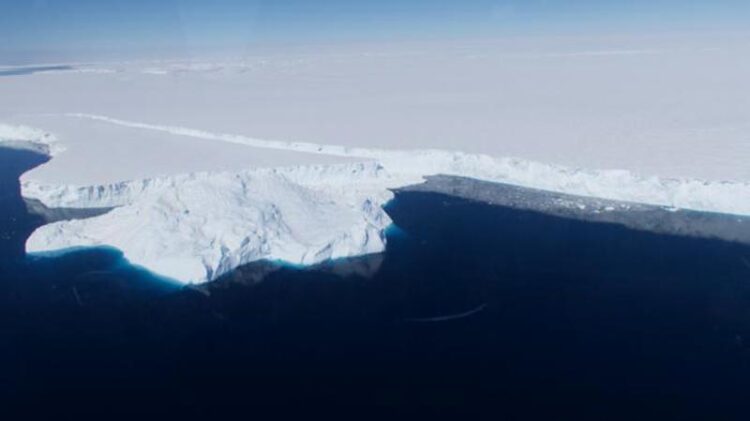Helicopter-based observations uncover warm ocean flows

The Totten Ice Shelf Photo: Yoshihiro Nakayama
… toward Totten Ice Shelf in Southeast Antarctica.
An international team of scientists has successfully conducted large-scale helicopter-based observations along the coast of East Antarctica and has identified pathways through which warm ocean water flows from the open ocean into ice shelf cavities for the first time.
During six days of observations, the team was able to retrieve temperature and other data at 67 sites covering the entire continental shelf region off the Totten Ice Shelf, the floating portion of the Totten Glacier. The study enabled the team to obtain an overall picture of warm ocean water flowing into the ice shelf cavity.
The Totten Glacier has attracted global attention because of the sheer scope of the environmental impacts if the glacier were to melt entirely: global sea levels could be raised by nearly four meters. It is thus necessary to observe the entire continental shelf region to understand the pathways and mechanisms of warm water mass inflow. However, such observations have been historically hindered by the region’s intense sea ice and icebergs.
A satellite photo of the region surrounding the Totten Glacier, showing the Totten Ice Shelf and Moscow University Ice Shelf, with sampling paths (orange lines), sampling locations (yellow and red circles), and the 1000 m depth contour (cyan outlines). (Yoshihiro Nakayama, et al. Geophysical Research Letters. September 11, 2023) Credit: Yoshihiro Nakayama, et al. Geophysical Research Letters. September 11, 2023
The team, including Assistant Professor Yoshihiro Nakayama and Associate Professor Shigeru Aoki of Hokkaido University’s Institute of Low Temperature Science, conducted helicopter-based observations with cooperation by Japan’s Maritime Self-Defense Force as part of the 61st Japanese Antarctic Research Expedition (JARE61).
Researchers took a CH-101 helicopter from the icebreaker Shirase to observation sites where they dropped two kinds of ocean observation sensors: AXCTD (Airborne eXpendable Conductivity, Temperature, and Depth) and AXBT (Airborne Bathy-Thermograph). The team was able to investigate underwater temperatures and salinity using data from the sensors.
The water temperature profiles at the sampling locations along each of the four sampling paths indicated in the previous figure. (Yoshihiro Nakayama, et al. Geophysical Research Letters. September 11, 2023) Credit: Yoshihiro Nakayama, et al. Geophysical Research Letters. September 11, 2023
The team found that broad ocean heat—stretching across the 150-kilometer range between the longitudes of 116.5° east and 120.5° east—was intruding toward the shelf. Seawater with a temperature of about 1℃ higher than the freezing temperature was observed between 50 and 100 meters above the seabed. This showed, for the first time, the overall picture of warm water mass flowing toward the Totten Ice Shelf.
This study also demonstrated the efficacy of using helicopters in conducting such research. They are cheaper and faster than operating an icebreaker, have superb maneuverability, and are not affected by sea ice conditions. The identified pathways can be observed in detail by icebreakers.
This study was conducted jointly by the Institute of Low Temperature Science; Hokkaido University, the Australian Antarctic Program Partnership at the University of Tasmania (Australia); Scripps Institution of Oceanography (U.S.A.); University of Texas at Austin (U.S.A.); the National Institute of Polar Research (Japan); Marine Works Japan Ltd. (Japan) and National Institute of Technology, Tomakomai College (Japan). The results of the study were published in the online edition of Geophysical Research Letters, a U.S. scientific journal on September 11, 2023.
Journal: Geophysical Research Letters
DOI: 10.1029/2022GL097864
Method of Research: Observational study
Subject of Research: Not applicable
Article Title: Helicopter-based ocean observations capture broad ocean intrusions towards the Totten Ice Shelf
Article Publication Date: 11-Sep-2023
All latest news from the category: Earth Sciences
Earth Sciences (also referred to as Geosciences), which deals with basic issues surrounding our planet, plays a vital role in the area of energy and raw materials supply.
Earth Sciences comprises subjects such as geology, geography, geological informatics, paleontology, mineralogy, petrography, crystallography, geophysics, geodesy, glaciology, cartography, photogrammetry, meteorology and seismology, early-warning systems, earthquake research and polar research.
Newest articles
Faster, more energy-efficient way to manufacture an industrially important chemical
Zirconium combined with silicon nitride enhances the conversion of propane — present in natural gas — needed to create in-demand plastic, polypropylene. Polypropylene is a common type of plastic found…

Energy planning in Ghana as a role model for the world
Improving the resilience of energy systems in the Global South. What criteria should we use to better plan for resilient energy systems? How do socio-economic, technical and climate change related…

Artificial blood vessels could improve heart bypass outcomes
Artificial blood vessels could improve heart bypass outcomes. 3D-printed blood vessels, which closely mimic the properties of human veins, could transform the treatment of cardiovascular diseases. Strong, flexible, gel-like tubes…





















